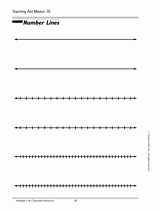How Can You Stretch Students' Thinking?
Help students identify whole-number relationships that are different from decimals, fractions, and integers. Students may unsuccessfully try to apply these relationships to decimals, fractions, or integers.
For example, while a three-digit whole number is less than a four-digit whole number, a three-digit decimal may be greater than, less than, or equal to a four-digit decimal (34.5 > 3.456, 1.11
The whole number 6 is greater than the whole number 5, but when unit fractions have these numerals as denominators, the relationship is reversed, and 1/5 > 1/6. Similarly, -5 > -6. Encourage students to use manipulatives and models to explore any misconceptions.
When Can You Use It?
Reading/English
For students in primary grades, read and discuss any of the many available counting books that illustrate numbers up to 10, 20, and so on.
Have students in intermediate grades identify ways that numbers are represented in print. Ask them questions such as, "When are numbers shown in standard form? Word form? Short-word form? When are actual numbers used? When are rounded numbers used?"
Writing
Ask students to write about number representations by defining and giving examples of different forms of numbers-standard, expanded, word, and short-word.
Math
Ten More and Ten Less
This lesson teaches primary students to use manipulatives to identify the number that is one more or one less than a given two-digit number.
Number Theory
This lesson asks intermediate and middle-school students to think about the many ways numbers can be described.
Odd and Even Numbers
A hundreds chart is used to show the alternating pattern of odd and even numbers, and students are asked to extend the pattern to identify additional odd and even numbers.
Social Studies
For students in primary grades, find and discuss different ways numbers are used in the environment (e.g., addresses, time, temperatures, grades, speed limits, phone numbers, on recyclable plastics).
Have students in intermediate grades find population figures for town or city, state, and country. Then ask them to compare and order the populations they found with those other students found.
Science
For students in primary grades, represent numbers with concrete objects. Choose linear measurements relating to science, such as the sizes of dinosaurs, and represent lengths using pieces of string or yarn. Label the strings, and then compare and order them. Make comparisons between string lengths, string length and classroom dimensions, string length and students' height, and so on.
Have students in intermediate grades discuss and practice writing numbers using scientific notation. Have them find examples of measures written with scientific notation and identify the situations in which they are used and why.













